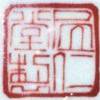 Jurentang, the "Hall where Benevolence Resides", in Zhongnanhai was the building in which Yuan Shikai (See: Chronology) lived and also where he had his office around 1915. In 1916 Guo Baochang, an antique dealer with a good relation to the court, was appointed to arrange for imperial Hongxian wares to be made and he also got a considerable amount of money to use for the purpose. What really came out of this project is still under debate. One opinion has it that all Hongxian marked pieces are made after the actual period and that the only possibly genuine mark of the Hongxian period are the ones with the "Jurentang" marks, if any. Still, from extant pieces it is clear that the porcelain industry was much stimulated at this time and for decades to come, and that pieces of very high quality was made, some of which bears the Hongxian mark while other are marked Jurentang.
Jurentang, the "Hall where Benevolence Resides", in Zhongnanhai was the building in which Yuan Shikai (See: Chronology) lived and also where he had his office around 1915. In 1916 Guo Baochang, an antique dealer with a good relation to the court, was appointed to arrange for imperial Hongxian wares to be made and he also got a considerable amount of money to use for the purpose. What really came out of this project is still under debate. One opinion has it that all Hongxian marked pieces are made after the actual period and that the only possibly genuine mark of the Hongxian period are the ones with the "Jurentang" marks, if any. Still, from extant pieces it is clear that the porcelain industry was much stimulated at this time and for decades to come, and that pieces of very high quality was made, some of which bears the Hongxian mark while other are marked Jurentang.
An explanation is given in Prof. XIONG Liao's book "a Directory of Antique Ceramics", published in 1993 with ISBN: 957-622-112-1. His book is based on Zhao Ruzhen's book Guwan zhinan "A Guide to Antiques", Beiping 1942 and then abridged and republished in 1992 & 1995 with ISBN: 7-200-0181-X/Z.204.
At pages 58 & 59 in Prof. Xiong's book he explains that Yuan Shikai (proclaimed Emperor 12.12.1915 and reign commenced 01.01.1916) sent Guo Baochang to Jingdezhen to oversee his new imperial porcelain production. The intent from the outset was that the items produced were to be of excellent quality. The biscuit used was very thin, the enamels were sent from the Imperial Workshops and the mark used was a red seal "Jurentang".
Jurentang was a Russian-style reception hall within Zhongnanhai, built by Guangxu and named 'Hoi Yin Tang', (Kwan: Yiluan Dian) and renamed 'Jurentang' by Yuan Shikai when he took up residence in the building, initially as President of China.
The quality of items produced was reputed to be excellent. Unfortunately during production, because of the very thin biscuit, many, many items were damaged. The remaining few perfect items were given to the most favoured officials. They are therefore very rare and very valuable; the production run being limited to the 83 day window which Charles noted.
Yuan Shikai stood down as (Hongxian) Emperor on 22.03.1916 and resumed his presidency and died in June 1916. After his death the kilns and production were destroyed, however the enamels were stolen by the workers who then proceeded to copy the 'Jurentang' production and gave it the fake label Hongxian Nian Zhi or Hongxian Yu Chih or Hongxian Yuan Nian, mostly with Kaishu script. Hongxian being the reign name that Yuan had given himself.
The first copies produced were apparently extremely good quality as they were still using the imperial biscuit and enamels, but quality fell as the quantity increased and, presumably, the imperial resources were depleted.
Thus the belief is that all items marked Hongxian are fakes and that the only representative ceramics from that short 83 day period are Jurentang - which in itself was also copied.
There is a bowl kept in the Beijing Museum (considered to be genuine Hongxian) that carries an underglazed blue Ju Ren Tang Zhi mark in Zuanshu script. The design of the bowl is after Qianlong and all the decorative elements resembled some of those pieces found in the Qing period. At page 62 in Zhao Ru zhen's book, first written in 1942 the author is quite emphatic in stating that ALL Ju Ren Tang porcelain produced during the 83-day window was ONLY marked in red seal script.
A